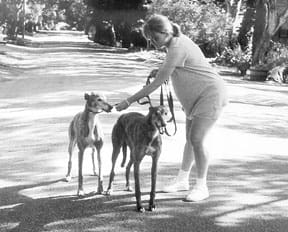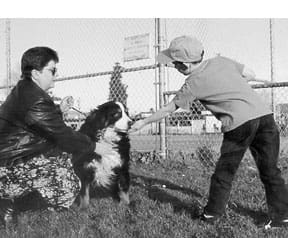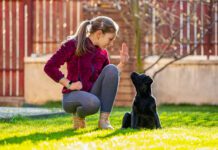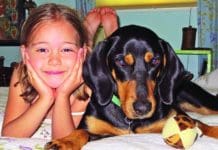[Updated February 27, 2018]
“Family Dog Mauls Toddler!”
We’ve all seen similarly sensational headlines. In the article that follows such an alarming title, there’s usually a quote somewhere about the tragic attack being unprovoked and totally unexpected. Yet dogs rarely attack without provocation, and in most cases the offending dog has been sending signals for quite some time that he was not comfortable with the presence of the child. If the parents had been better educated about dog behavior, and had been paying better attention, the tragedy quite likely could have been averted through proper management of child/dog interactions. Better still, it could have been prevented through proper training and socialization of the dog from puppyhood on.
How Dog-Baby Tragedies Happen

Many young couples acquire a puppy early in their relationship, long before the advent of the first baby. The puppy is a surrogate child, and the couple dotes on him – taking him everywhere, allowing him to sleep on the furniture, even share the marriage bed. For several years the dog enjoys his status as an only child. The couple tends to socialize with other childless adults, and the dog rarely sees children. Then the couple decides to have a baby. Now we have a problem.
Dogs are genetically “hardwired” to absorb much of the information about their environment in a critical learning period in the first few months of their lives. During this time, usually somewhere between the ages of five weeks and five months, a puppy’s brain files away information about which things in the world are safe and rewarding, which ones are painful and dangerous and should be avoided, and which have no consequence. Anything not experienced during this critical period tends to automatically get filed in the “dangerous” category. This early imprinting helps wild animals survive; if they don’t know for sure that something is harmless, the safest assumption is that it is not.
Herein lies the problem. If a puppy doesn’t learn that children are “safe and rewarding” during those critical months, he is likely to assume, when he meets them later in life, that they are a threat. This assumption is often supported by the behavior of many of the children that a dog meets. Small children are likely to poke fingers into canine ears, prod them with pencils, hit them over the head with wooden blocks and pull tails or fur. They stare directly into a dog’s eyes (a direct stare is a threat in the canine world). They compete for toys and food. They move erratically – run, trip, fall, swing their arms around – and make weird noises.
In a perfect world, every new puppy would be thoroughly socialized to babies, toddlers, and children while he was in his critical learning period. Despite many veterinarians’ recommendations that their clients wrap their puppies in cotton wool and keep them strictly at home until they have been fully vaccinated, it is vitally important that your puppy have positive experiences with all sorts of human stimuli during his first five months. Fortunately, this can be accomplished without exposing Buddy to life-threatening diseases.
Invite lots of people, including babies and children, vaccinated healthy puppies and friendly dogs, over to your house for puppy parties. Give everyone handfuls of really yummy treats to feed to Buddy. (Tell everyone Buddy has to sit to get his treats and you will also be teaching him not to jump up on people at the same time.) Monitor your pup’s interactions with children to be sure they are all positive. If Buddy acts fearful, don’t force him to greet people. Ask your friends to toss treats from a distance until Buddy gains confidence and approaches them. Have children of all ages feed Buddy lots of treats and he will quickly decide that kids are a good thing, not dangerous.
You can also take Buddy out into the community to safe canine-friendly locations. Don’t go to the local dog hangout and turn him loose to play, but do take him with you to places such as a well-run puppy kindergarten class, where you can monitor his interactions with kids and other puppies. Teach him that the world, especially the small humans of the world, are a source of pleasure and reward, and you greatly reduce the risk of “Dog Mauls Toddler” headlines in your family’s future.
Conditioning Dogs for Children: It’s Never Too Late
Maybe it’s too late to socialize your Buddy to children during his critical learning period, because that stage of his life has long passed. Is it too late to teach him to live with children? Not necessarily. It is more difficult, but not impossible. This was the challenge presented early last summer when Kristin and Fred Wolf called Peaceable Paws, my dog training business, and asked for help in preparing their two dogs, Helen and Charlie, to accept the imminent arrival of their baby, due to be born in late August.
Helen and Charlie, eight and five years old respectively, are both retired racing Greyhounds. As is often the case with rescued Greyhounds, they adapted beautifully to a life of luxury in a real home. The Wolfs hadn’t demanded much of them, but the dogs were housetrained, slept on their own beds, didn’t get up on the furniture, stayed in their fenced yard, and didn’t steal food from countertops.
The dogs had met babies on a few occasions. Helen was noncommittal, reported the Wolfs, but Charlie had exhibited what Kristin feared was an unhealthy interest, given the inherited prey drive that is encouraged in racing Greyhounds.
The expectant parents wanted to improve their dogs’ manners in general, but understandably, their primary concern was for the safety of the baby on the way.
Preparing a Dog for Baby’s Arrival
I arrived at the Wolf home in Carmel, California, and was greeted at the front door by two lithe, leggy, brindle Greyhounds and a very pregnant Kristin. As soon as Kristin let me in, Charlie jumped up on me. I turned my back and stepped away, repeating the maneuver when he circled me and tried to jump up again. After three repetitions of this circle dance, Charlie stood still with all four feet on the floor. I said “Yes!” in a happy voice and popped a treat in his mouth. For now, a stand was acceptable – we would work later on getting a sit in place of jumping up.
Kristin was impressed. So was Charlie. His teeth chattered with excitement as he thrust his chiseled head toward me in search of another treat. I pointedly ignored his pushy behavior, but gave him another “Yes!” and treat as soon as he backed off a step. Helen hovered in the background, and got a “Yes!” and treat just for being there. In this manner, we introduced the Wolf household to one of the basic tenets of positive reinforcement training: To the extent possible, ignore the behaviors we don’t want, and reward the ones we do. All living things tend to repeat behaviors that they find rewarding. The ones that don’t get rewarded eventually go away.
Fred Wolf joined us, and the five of us sat down in the living room to consider a training program. We started by listing the Wolfs’ concerns, questions and goals:
• Greyhound prey drive – threat to baby?
• Pulling on leashes: Helen, with lots of sniffing, but especially Charlie, who would lunge at cats and other dogs
• Getting overly excited about going out for a walk (Charlie)
• Jumping on people (Charlie)
• Shut the dogs away from the baby, or integrate them into baby routines?
• Goal: to keep the baby safe and maintain Charlie and Helen’s quality of life
I commended the Wolfs for thinking proactively and for wanting to continue keeping Helen and Charlie as full-fledged members of the family. Too many dogs are banned to the back yard, given away or surrendered to animal shelters when baby arrives. Others aren’t given a second thought until it’s too late – when a confused and defensive Buddy bites the baby. All too often the trainer gets called after the bite happens, when Buddy is one short step away from euthanasia. I was pleased that the Kristin and Fred were planning ahead, committed to doing the right thing for the dogs and the baby.
Managing Behavior is Often the Best Tool
We addressed the last question first. Given Charlie’s intense stare at other babies he had been with, the Wolfs were naturally concerned about his prey drive. They had read in a dog-and-baby book that an intense stare was a serious red alert, a sign that the dog had dastardly designs on the baby. Would the baby ever be safe around a predatory animal who had been taught to chase down small animals?
I downplayed the threat of Charlie’s intense gaze while emphasizing the need for constant supervision of interactions between dogs and young children. There is a huge difference between a fleeing rabbit and a relatively stationary baby in a crib. Most dogs have no difficulty distinguishing humans from prey animals.
Perhaps Charlie was just intrigued by the sounds and smells of a human puppy. Still, no small child should ever be left alone with a dog even for a few seconds, no matter how trusted the canine companion. A dog who hasn’t had many experiences with babies is certainly an unknown, but as long as Charlie and Helen were not given an opportunity to do something wrong, the baby would be safe. This is another basic tenet of positive training: Manage the environment to prevent inappropriate behaviors from happening. If you don’t want your dog to counter-surf, never leave the roast on the counter when you leave the room. If you don’t want your dog to bite your small child, never leave the two of them alone together. Ever.
I advised the Wolfs that it was important to implement any anticipated changes in the dogs’ routine and privileges now, so the changes would not be associated negatively with the baby’s arrival.
We scheduled training sessions twice a week for several weeks to work on improving the communication between the four current members of the Wolf pack, so the humans would be prepared to manage the behavior of the canines once baby made five.
The goal of all the work was to ensure that when the baby arrived, the dogs would associate her presence with good things (lots of treats and attention), not bad things (when baby is here, dogs get shut away).
Dog Training for Baby’s Arrival
Charlie and Helen took well to reward-based training. Helen, older and a little arthritic, was slower to respond, but also less energetic than Charlie, so we focused much of our efforts on gently controlling the younger dog. We used “Yes” as our reward marker rather than a clicker, for two reasons. Charlie is very sound-sensitive and would not have responded well to a clicker. Even if he had, we anticipated that Kristin, with her hands full of baby, would find it easier to use a verbal marker. We identified a number of behaviors that would be useful for the dogs to know:
• Sit
• Down
• Stay
• Wait
• Go To Your Rug
• Off
• Go First
• Over Here
Sit, down, stay and wait are behaviors commonly taught in training classes. Although some trainers use choke chains, prong collars and physical corrections to teach these basic behaviors, it is certainly not necessary to do so. We used a treat as a lure to get Charlie and Helen to offer the behaviors, followed by a verbal “Yes!” and a reward.
For example, to teach the sit, we held the treat just above the dog’s head. Most dogs will sit to watch the treat, since that’s easier than standing with a bent neck. When the dog sits, say “Yes!” or Click! the clicker, then feed the treat.
After a couple of dozen repetitions, say “Sit” first, wait a second or two to see if the dog responds, then move the treat over his head, Click! or “Yes!” when he sits, and reward. In short order, the dog will sit when you say the word, without any luring. Continue to Click!/”Yes!” and reward until the behavior is deeply programmed in the dog’s brain.
“Go to your rug” would enable the Wolfs to send Charlie and Helen to a predetermined spot, such as a rug in the nursery. This would allow the dogs to keep Kristin and the baby company in the nursery instead of having to be shut out for always being underfoot – a common dog/baby management problem. We used the treat to lure the dogs to the rug and lie down, while giving the verbal cue “Go to your rug.” Both dogs became proficient at this in a couple of weeks, and quickly learned to stay on their rugs until released with a sprightly, “OK!”
“Off” (meaning “whatever you are paying attention to at this moment, I want you to leave it alone”) has unlimited applications. The object of the dog’s attention could be the baby, a teething ring, a dropped Arrowroot biscuit, a visitor at the door, the neighbor’s cat, a rotting, discarded hamburger in the gutter, or a dead seal on the beach. “Off” can be taught using punishment – a jerk on the collar when the dog goes for the forbidden object, but of course, we chose a more positive training approach!

With Charlie sitting in front of me, I offered him a treat in my closed fist, and said the word “Off” just one time. Naturally he was curious and inspected the fist, trying to get at the treat inside. I waited patiently until he got bored and glanced away, then said “Yes!” and gave him a treat from my other hand. In just a few repetitions he began glancing away from the fist with a treat hidden in it as soon as it was offered with the word “Off.” He was learning that he got a reward at least as good as the forbidden one, if he left it alone when he heard the cue “Off.” We then repeated the exercise with the forbidden treat in an open hand (closing the hand into a fist if he tried to get the treat, but always saying the word “Off” only one time). Finally I placed the treat on the floor, using my hand or foot to cover the treat if he tried to get it. Like most dogs, Charlie and Helen learned the “Off” concept in one session.
Because Charlie had a dangerous habit of bounding down the stairs while Kristin was descending, we decided to teach him “Go First” as well as “Wait.” “Wait” means “pause,” and is sort of an informal stay that doesn’t require the dog to remain fixed in one position. We could use “Wait” to ask Charlie and Helen to not go up or down the stairs until Kristin had completed the trip. We also taught Charlie “Go First,” so she could send him down the stairs ahead of her. This one was simple. We stood at the top of the stairs and told Charlie “Go First,” then tossed a treat down the stairs. When Charlie charged down the stairs after the treat he got a “Yes!” His reward was the treat that was already waiting for him at the bottom of the staircase. The hardest part of this exercise was “fading” the treat toss – Charlie tended to wait until the treat was tossed before he would go down the stairs. Eventually, he learned he’d also get a treat after he went down the stairs after just the verbal cue.
Training a Dog for Babies Starts with Good Manners
We anticipated that the hardest part of the training would be teaching Charlie to stop lunging at cats and other dogs on his daily walks. We were pleasantly surprised. Charlie was so enamored of the positive training method that it was easy to get him to focus on us (and a treat) instead of prey. We started with a Snoot Loop head halter for control, but quickly returned to a plain buckle collar when it became apparent that he didn’t need the halter.
Since Charlie tended to get overexcited when Kristin picked up his leash to attach it to his collar, we tried a little negative punishment. (Negative punishment means the dog’s behavior makes a good thing go away. It is not a physical correction.) Kristin picked up the leash and Charlie started leaping and cavorting about. Kristin put the leash down. (Leaping and cavorting makes the good thing – the leash and the imminent walk – go away.) When Charlie calmed down, Kristin picked up the leash again. Every time Charlie got excited, Kristin put down the leash. In just a few repetitions, Charlie ran to the door and sat perfectly still – a behavior he had previously performed for Fred, but had never done for Kristin.
Once outside, we taught Charlie an “Over here!” cue, which meant “turn your attention back to me.” We started by using it when Charlie was distracted and sniffing a bush, rewarding him with a “Yes!” and treat when he looked back at us. We had practiced a mere half-dozen times before we encountered a barking dog dashing back and forth on a deck. Charlie never gave the dog a second glance – he was much too interested in the treat in Kristin’s hand. Mission accomplished!
Finally, we encouraged both dogs to walk on a loose leash by rewarding them with a “Yes!” and treat whenever they were walking without pulling. We did this with each dog individually at first, and at our last session Kristin tried walking the dogs together. That part of the program still needs some work, but it was a definite improvement!
When the Baby Comes
Molly Wolf was born on Monday, August 23 – a tiny 5 pounds, 11 ounces. A week after her arrival, the Wolfs were delighted with the dogs’ behavior around the new member of the pack.
“They’re doing great,” reported Kristin. “They were frenzied with curiosity the first couple of days, but we just kept rewarding them whenever they turned their attention away from Molly. At first Charlie was locked onto her like radar. Now, already, they are both so respectful of her space. If am sitting on the sofa feeding her, Charlie will come in and lie down at my feet. Not too long ago he would have insisted on having his head in my lap.”
Following their training sessions, Kristen and Fred Wolf now know to continue to reward and reinforce the dogs’ positive behavior (such as lying down at Kristen’s feet when she’s feeding the baby), rather than ignoring them. They’ve seen for themselves what a powerful tool positive reinforcement can be.
“I am so pleased that we got help,” Kristin continues. “We would have done all the wrong things – corrected them, told them ‘No!’ for looking at the baby, shut them out of the room – it would have been a disaster. We are very pleased.”
I am very pleased too. It is a pleasure to work with people who respect their dogs and truly have their best interests at heart. I expect that Kristin, Fred, Charlie, Helen and Molly Wolf will have long, happy lives together.
Pat Miller, a dog trainer from Salinas, California, has been a regular contributor to WDJ for its 20 years of publication.






